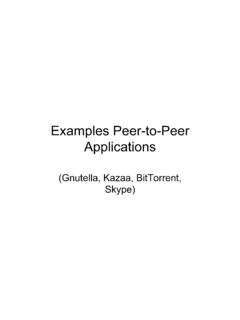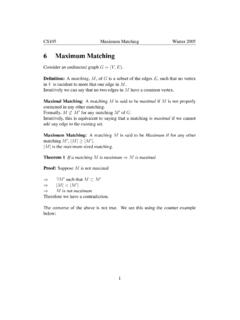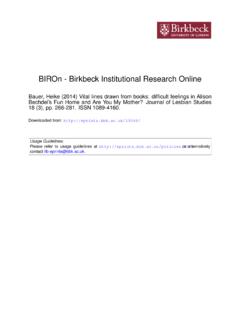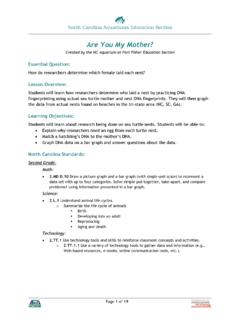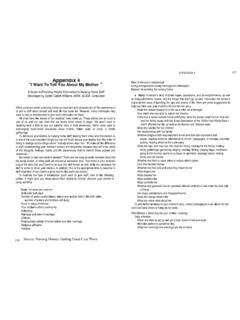Transcription of Are You My Mother…Tongue? - cs.dartmouth.edu
1 Are You My story of the Tower of Babel is the creationist s version of the origin oflanguage diversity: Man, in one of his many hubristic moments decides tobuild a tower to Heaven. God, realizing that communication is the key tocompleting any massive public works project, foils the plan by replacing thesingle common language of the workers by many different languages,thereby making impossible their cooperation, not to mention the schedulingof car pools and the organization of a softball there a true mother tongue to which all existent modern languages cantrace their origin? More precisely, what is the genealogical tree or phylogenyof language? It is these sorts of questions, the ones that look to tell a story ofa branching journey of the development of languages that is the goal ofSFI s Evolution of Human Languages (EHL) Project, funded by the John Catherine T.
2 MacArthur Foundation, and spearheaded by SFID istinguished Fellow Murray Gell-Mann and Russian Academy of SciencesMember (and frequent SFI visitor) Sergei Starostin. The third leader of theproject is Dr. Merritt Ruhlen from Stanford University, author of themonographs "Guide to the World's Languages" and "The Origin ofLanguages".The EHL project falls squarely within the discipline of comparativelinguistics. The last two hundred years or so of the subject have beendevoted to the clarification of the most elementary stages of linguisticorganization, an effort which has resulted in a partitioning of the roughly sixthousand attested languages into several hundred more fundamental language families , each of which implies the existence of a singlelanguage ancestor for its family standard methodology used to show relatedness involves theidentification of a set of phonetic similarities between the words in therespective basic vocabularies (eg.)
3 , words for body parts, numerals, naturalphenomena etc.). This is the sort of comparison that supports the existenceof a common Germanic language able to account for the English hundred and the German hundert , or uses the Italian cento and the French cent as evidence for an older ancestral Romance language - actually attested asLatin. The reconstructed protolanguages are then grouped together intofamilies of the next level, in our case forming the so called Indo-Europeanfamily. It is estimated that its proto-language was spoken (in a homeland thatis still a matter of dispute) some six or seven thousand years ago. A numberof other universally recognized families have similar "time depths".Although many comparative linguists maintain that further classification isimpossible because too many changes impede comparison andreconstruction, a few bold scholars go further to find superfamiliescomposed of several such families, with protolanguages spoken thousands ofyears earlier.
4 Instead of comparing modern languages they use thereconstructed protolanguages that are naturally closer to each other thantheir modern is the so-called step-by-step reconstruction, a technique due to theRussian school of comparative linguistics first used in the construction ofEurasiatic proto-language. After several decades of research the evidence formacrofamilies became overwhelming, and there are many indications thateven those can be further grouped together suggesting the existence at somepoint in time of a single common achievements are, in the words of Starostin, "pre-science", insofar asthey are obtained without mathematical tools. However, it is in the searchfor deeper levels of organization, and in the investigation of temporalconsiderations, that the tools of mathematics and statistics truly come to theforefront, marking a transition from pre-science to science for comparativelinguistics, and the starting point of the discipline of lexicostatistics or"glottochronology", originally started in the US by Maurice Swadesh.
5 It is inthis domain that SFI is making a big is fitting that Gell-Mann is the person leading this search. The son of thefounder of the Arthur Gell-Mann School for Languages (which taughtEnglish to immigrants and other languages to Americans), Gell-Mann hasbeen interested in etymologies and language sound systems since essence, what Gell-Mann and Starostin seek is the linguistic equivalent ofGell-Mann s Nobel Prize winning Eightfold Way , his insightful 1950 sreorganization of what was then a zoo of particles (over one hundred ofthem) thought to be the fundamental constituents of nuclear matter. Bygrouping them according to certain approximate symmetry conditions, andcreating new mathematical techniques for their study, Gell-Mann was able tosee this apparent confusion of particle types as parts of a more coherentwhole.
6 The reorganization suggested a new, more basic fundamental particlewhich Gell-Mann named the quark, as responsible for this "zoo", and in sodoing, he brought our understanding of the story of matter closer to thebeginning of time. By fusing his great love of language with his scientificproclivities he has found what seems to be a promising approach toward thesearch for the Mother the heart of the problem is estimating the rate at which languages change,as measured by the changes that occur in the basic vocabulary as it passesfrom generation to generation, passed on like genes of cultural DNA . Thebasic principles underlying the model formulation are that language requiresstability to ensure communication between generations, but that neverthelessthere is inevitable information drift, resulting in changes duringtransmission.
7 The latter takes place via a mechanism of replacement whichoccurs either through borrowing or through synonymic shift. Replacementby borrowing occurs when a word is replaced by its foreign equivalent: anexample is mountain , borrowed from French to English, supplanting theold English berg . Replacement by synonym occurs within a languagewhen a word drifts to a new, but nearly equivalent meaning. An example ofthis is the current usage of the word kill , which has its origins in theGermanic word for torture. Keeping in mind the genetic model, these sortsof language mutations are akin to horizontal and vertical replacement(transmission) in genetics which result in the evolution of a particulargenetic the replacement by borrowing is unpredictable, replacement bysynonym seems to follow a standard model of genetic drift, the mechanismwhich many believe is responsible in biology for the species diversity we seetoday.
8 In the context of language this model provides a means by which thetimes of language divergence can be estimated. At work here is an implicitassumption of a regular process of change which Starostin likens to themeasurable rate of isotope decay that makes carbon-dating the exact sciencethat it is today. The glottochronological version of carbon-dating suggeststhat one word of basic vocabulary is replaced roughly every 200 to 300 yearsor about 5 over a millennium. The original model assigns approximately thesame probability of replacement to each word in the basic vocabulary. Thismodel is quite na ve and Gell-Mann is leading an effort directed towardtuning the model using more realistic estimates of replacement probabilitiesof individual techniques appear to reliably reconstruct the proto-languages inuse six to seven thousand years ago.
9 In addition, there is striking evidencefor the existence of about ten superfamilies responsible for all languagesin use today. The analysis reveals some interesting family relations, forexample, indicating that northeast Asian languages such as Korean andJapanese are closer to European languages that southeast Asian languages(eg., Chinese). CaucasianSino-CaucasianDene-CaucasianMia o-YaoAustro-AsiaticThai-KadaiAustronesia nAustro-TaiAustricOmoticCushiticBerberCh adicEgyptianSemiticAfroasiaticKartvelian AinuChukchee-KamchatkanDravidianIndo-Eur opeanEskimo-AleutAltaicUralicYukaghirNiv ghEurasiaticNostraticBoreanFigure1: Genealogical tree of the languages of the Old World (with time-scale in millennia),obtained on the basis of comparing lists of the thirty-five most stable words in various languagefamilies of Northern Africa and Eurasia.
10 The margin of error at the deepest points in the tree is onthe order of one a theoretical ( , model building) component of the EHL program ispaired with (if not made possible by) a huge empirical component. Starostinis also a co-author of the recently completed Etymological Dictionary ofAltaic Languages which gives a comparative study of the Altaic languages.!k ro to fight, kill: Tung. *kere-, *kerbe-; Mong. *kere-; Turk. *gEr _-; Jpn. *k_r-; Kor. * *kere-, *kerbe- 1 kill 2 to fine 3 to slander 4 to revenge (1 _____ 2 _____ 3 _____ 4 _____): Evk. kerbe-1, kerem_- 3, kerem_u bi- 4; Man. keru-le- 2, keru-n fine . ___ 1, 381, 452, 453, *kere- 1 to quarrel, to fight 2 to be angry (1 _____, _____ 2 _____): MMong. kere- (SH), kir ldu-(MA), keurde- (IM) 1; WMong. kere-, kereld - (L 457) 1, kere_e- 2; Kh.



